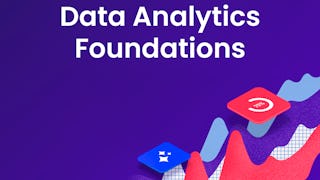This course offers students an opportunity to learn fundamentals of computation required to understand and analyze real world data. The course helps students to work with modern data structures, apply data cleaning and data wrangling operations. The course covers conceptual and practical applications of probability and distribution, cluster analysis, text analysis and time series analysis.



Compétences que vous acquerrez
- Catégorie : Probability
- Catégorie : Network Analysis
- Catégorie : Time Series Analysis and Forecasting
- Catégorie : Text Mining
- Catégorie : Statistics
- Catégorie : Data Analysis
- Catégorie : Exploratory Data Analysis
- Catégorie : Data Cleansing
- Catégorie : Correlation Analysis
- Catégorie : Natural Language Processing
- Catégorie : Probability Distribution
- Catégorie : Computational Thinking
- Catégorie : Data Structures
- Catégorie : Data Wrangling
Détails à connaître

Ajouter à votre profil LinkedIn
juillet 2025
13 devoirs
Découvrez comment les employés des entreprises prestigieuses maîtrisent des compétences recherchées

Il y a 7 modules dans ce cours
In this module, you will explore the realm of time series data, gaining a comprehensive understanding of its characteristics, components (trend, seasonality, and noise), and prevalent sources across diverse domains. Through effective visualization techniques and descriptive statistics, you will acquire the skills to recognize patterns and trends within time series data.
Inclus
5 vidéos5 lectures2 devoirs
This module focuses on feature extraction in time series data analysis, emphasizing the identification and utilization of diverse features. We will explore how these features capture essential information, enabling a comprehensive understanding of time series data. You will gain practical insights into the application of various feature types, enhancing your ability to extract meaningful patterns and make informed analyses in the dynamic field of time series data analysis.
Inclus
5 vidéos5 lectures3 devoirs
This module focuses on the comprehensive preprocessing and analysis of textual data. You will acquire practical skills in text data preprocessing, encompassing tasks such as tokenization, stemming, and stopword removal. We will discuss diverse methods for representing text data, including bag-of-words (BoW), Term Frequency-Inverse Document Frequency (TF-IDF), and word embeddings. We will also explore various text analysis techniques such as sentiment analysis, topic modeling, and named entity recognition. The practical application of these techniques enables you to extract meaningful insights, patterns, and nuanced meanings from textual data, empowering you to navigate and derive value from the intricate landscape of text analysis.
Inclus
2 vidéos2 lectures2 devoirs
In this module, we examine network theory, equipping you with a foundational understanding of nodes, edges, and graphs. We will explore various network types, from social networks to keyword co-occurrence networks, learning to discern their relevance in diverse domains. Practical application includes extracting and creating keyword co-occurrence networks from text data through preprocessing, keyword identification, and relationship construction. You will then analyze these networks, employing measures like centrality and community detection, enhancing your ability to interpret results. This module culminates in the extraction of meaningful insights, enabling you to identify keywords and thematic clusters within textual data through the lens of network analysis.
Inclus
3 vidéos3 lectures2 devoirs
In this module, we examine network theory, equipping you with a foundational understanding of nodes, edges, and graphs. We will explore various network types, from social networks to keyword co-occurrence networks, learning to discern their relevance in diverse domains. Practical application includes extracting and creating keyword co-occurrence networks from text data through preprocessing, keyword identification, and relationship construction. You will then analyze these networks, employing measures like centrality and community detection, enhancing your ability to interpret results. This module culminates in the extraction of meaningful insights, enabling you to identify keywords and thematic clusters within textual data through the lens of network analysis.
Inclus
2 vidéos4 lectures2 devoirs
In this module, you will inspect the intricate world of joint probability distributions. You will develop the skill to identify and interpret these distributions, employing probability mass functions (PMFs) for discrete variables and probability density functions (PDFs) for continuous variables. This module will further equip you with the capability to calculate and interpret marginal probability distributions, involving the summing or integrating of variables within a joint distribution. The theoretical insights and practical calculations will help you gain a complete understanding of the relationships between variables and the nuanced exploration of joint, marginal, and conditional probability distributions.
Inclus
1 vidéo2 lectures1 devoir
In this module, you will explore the fundamental concept of mathematical expectation, or expected value, in probability theory. Through theory and practice, you will calculate the expected value for both discrete and continuous random variables, gaining insights into its significance as a measure of central tendency. We will also explore the statistical concepts of covariance and correlation, guiding participants in the calculation of coefficients to quantify relationships between pairs of random variables. Interpretation of these results allows you to classify the degree and direction of association through positive, negative, or zero covariance/correlation values. Additionally, the module addresses the concept of independence, elucidating its relationship with zero covariance and correlation.
Inclus
3 vidéos5 lectures1 devoir
Obtenez un certificat professionnel
Ajoutez ce titre à votre profil LinkedIn, à votre curriculum vitae ou à votre CV. Partagez-le sur les médias sociaux et dans votre évaluation des performances.
Instructeur

Offert par
En savoir plus sur Data Analysis
 Statut : Essai gratuit
Statut : Essai gratuitDeepLearning.AI
 Statut : Prévisualisation
Statut : PrévisualisationNortheastern University
 Statut : Prévisualisation
Statut : PrévisualisationUniversity of Illinois Urbana-Champaign
 Statut : Essai gratuit
Statut : Essai gratuitUniversity of London
Pour quelles raisons les étudiants sur Coursera nous choisissent-ils pour leur carrière ?





Ouvrez de nouvelles portes avec Coursera Plus
Accès illimité à 10,000+ cours de niveau international, projets pratiques et programmes de certification prêts à l'emploi - tous inclus dans votre abonnement.
Faites progresser votre carrière avec un diplôme en ligne
Obtenez un diplôme auprès d’universités de renommée mondiale - 100 % en ligne
Rejoignez plus de 3 400 entreprises mondiales qui ont choisi Coursera pour les affaires
Améliorez les compétences de vos employés pour exceller dans l’économie numérique
Foire Aux Questions
Access to lectures and assignments depends on your type of enrollment. If you take a course in audit mode, you will be able to see most course materials for free. To access graded assignments and to earn a Certificate, you will need to purchase the Certificate experience, during or after your audit. If you don't see the audit option:
The course may not offer an audit option. You can try a Free Trial instead, or apply for Financial Aid.
The course may offer 'Full Course, No Certificate' instead. This option lets you see all course materials, submit required assessments, and get a final grade. This also means that you will not be able to purchase a Certificate experience.
When you purchase a Certificate you get access to all course materials, including graded assignments. Upon completing the course, your electronic Certificate will be added to your Accomplishments page - from there, you can print your Certificate or add it to your LinkedIn profile. If you only want to read and view the course content, you can audit the course for free.
You will be eligible for a full refund until two weeks after your payment date, or (for courses that have just launched) until two weeks after the first session of the course begins, whichever is later. You cannot receive a refund once you’ve earned a Course Certificate, even if you complete the course within the two-week refund period. See our full refund policy.
Plus de questions
Aide financière disponible,


